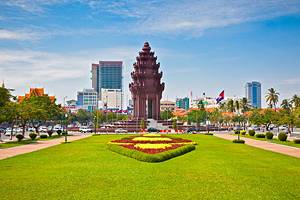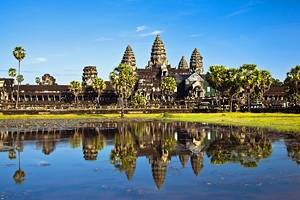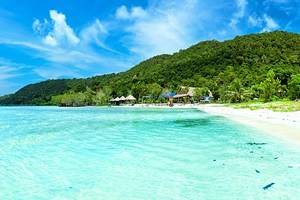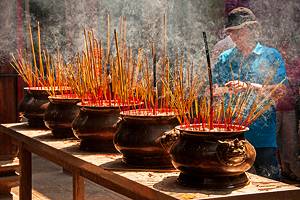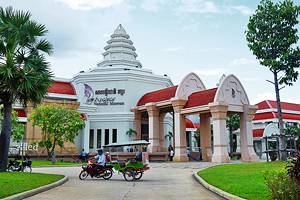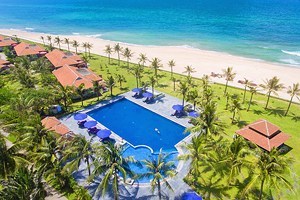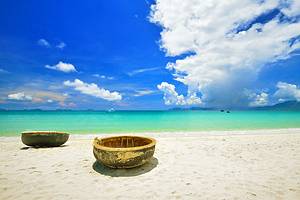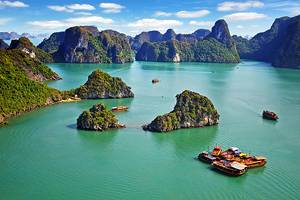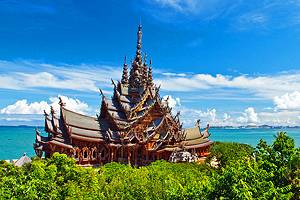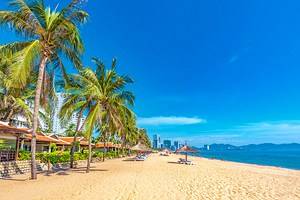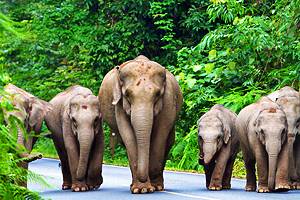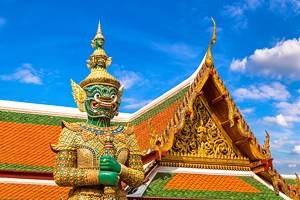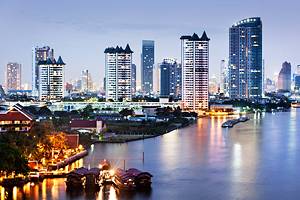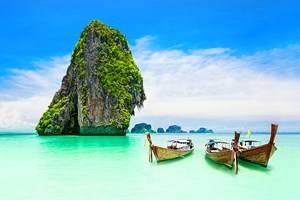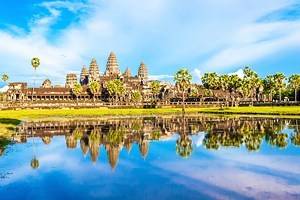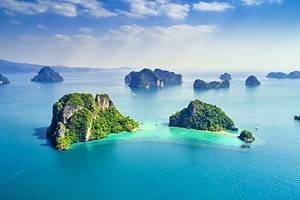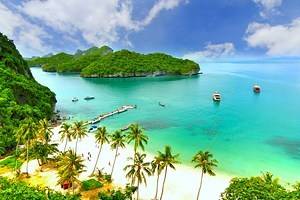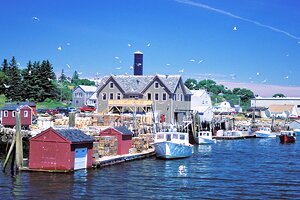15 Top-Rated Attractions & Things to Do in Phnom Penh
Vibrant, bustling Phnom Penh is the heartbeat of Cambodia. This sprawling capital, spread out beside the banks of both the Tonlé Sap and Mekong Rivers, is a city of wide central boulevards and skinny back alleys, where modern and old collide.
The Royal Palace complex is the city's top attraction but for anyone interested in exploring Cambodia's 20th-century history, Phnom Penh is also a vital stop, for it is home to two of the country's most sobering places to visit.
The Killing Fields of Choeung Ek and Tuol Sleng Museum (the prison of S-21) both provide an insight into the reign of terror this nation suffered under Khmer Rouge rule.
Travelers heading out to Cambodia's premier tourist attraction of Angkor Wat also benefit hugely from a stop in the capital, as the wonderful National Museum of Angkor is here.
For more ideas on your sightseeing options, read our list of the top attractions and things to do in Phnom Penh.
- 1. Admire the Architecture of the Royal Palace
- 2. See the Exhibits inside the Cambodia National Museum
- 3. Visit the Killing Fields of Choeung Ek
- 4. View Tuol Sleng Museum
- 5. Cruise on Phnom Penh's Rivers
- 6. Wat Phnom
- 7. See the Stupas of Wat Ounalom
- 8. Shop in the Russian Market
- 9. Experience the Psar Thmei Shopping Scene
- 10. See Phnom Penh's Independence Monument
- 11. Watch the Cambodian Living Arts Performance
- 12. Stroll Sisowath Quay
- 13. Cycle around Koh Dach & Koh Okhna Tei Islands
- 14. Take in the Views from the Temples of Oudong
- 15. Take a Day Trip to Phnom Chisor
- Map of Attractions & Things to Do in Phnom Penh
- Where to Stay in Phnom Penh for Sightseeing
- Frequently Asked Questions
- When is the best time to visit Phnom Penh?
- How far is the airport from the city and what is the best way to get there?
1. Admire the Architecture of the Royal Palace
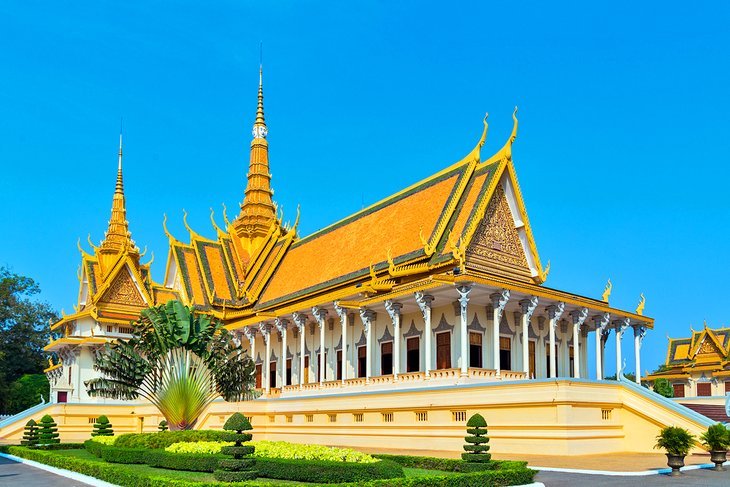
The highlight of Phnom Penh is the beautiful Royal Palace - the seat and residence of Cambodia's royal family since the 1860s.
The spired-roof pavilions of the complex are an excellent example of classic Khmer architecture.
Both the Throne Hall area and the Silver Pagoda - set within manicured gardens - are open to the public for visiting. The Throne Hall was built in 1917, replacing an earlier wooden structure.
The Silver Pagoda is famed for being the home of the Emerald Buddha statue and a mammoth 90-kilogram Gold Buddha statue studded with thousands of diamonds.
The Silver Pagoda escaped the brutal destruction of the Khmer Rouge reign and so still contains some beautiful artifacts. The interior ceiling mural depicts the Cambodian epic poem, the Reamker, which is based on the story of the Indian Ramayana.
Address: Sothearos Boulevard, Phnom Penh
2. See the Exhibits inside the Cambodia National Museum
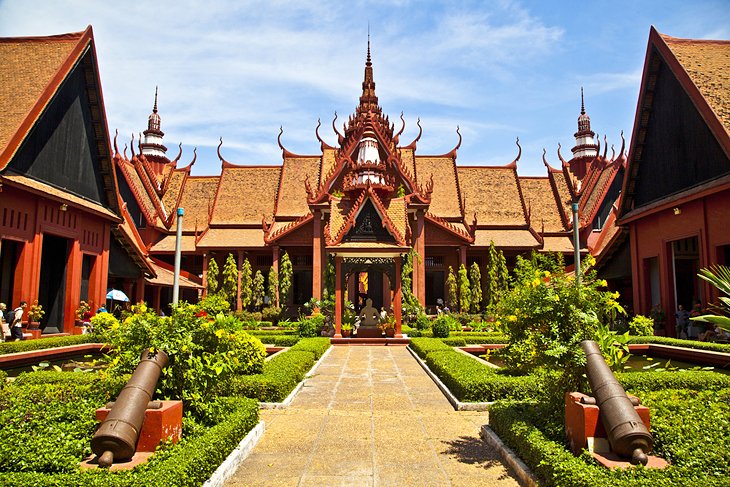
The traditional Khmer building that houses the national collection was built in 1920.
Inside, the dazzling array of ancient Khmer artistry, with more than 1,800 objects on display, is a must visit for anyone with an interest in Cambodian history.
The major highlights of the museum galleries are the Vishnu head excavated near the vast temple complex of Angkor Wat; the incredible Angkorian collection, with statues from the temples of Koh Ker and Angkor Thom; and the large exhibit of pre-Angkorian artifacts that trace Cambodia's Funan and Chenla periods.
Address: Street 13, Phnom Penh
Official site: www.cambodiamuseum.info
3. Visit the Killing Fields of Choeung Ek
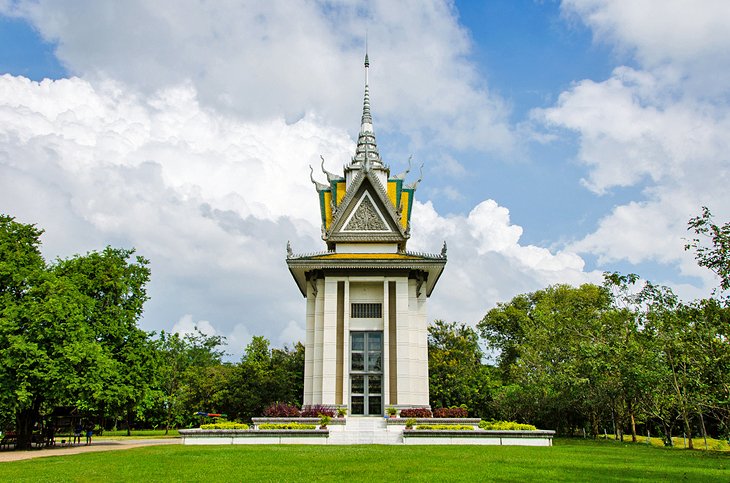
The Killing Fields of Choeung Ek are a somber reminder of the terror of the Khmer Rouge whose brutal regime, intending to turn Cambodia into a socialist agrarian society, ruled the country between 1975 and early 1979.
In under four years, it's estimated that between one and three million Cambodians were killed under Pol Pot's authoritarian command.
Many perished because of famine and disease, but also hundreds of thousands of Cambodians – intellectuals, educated people such as teachers and doctors, regime opponents, and simply anyone suspected of being an opponent – were murdered.
Here at Choeung Ek, it's estimated that 17,000 people met their death. The victims here came from S-21, the Khmer Rouge's high-security prison that is now Tuol Sleng Museum.
There are 129 mass graves here, 86 that have been excavated, exhuming the remains of 8,985 people. At the center of the area is a memorial stupa that contains more than 8,000 skulls.
A visit here is an entirely sobering experience that will aid in your understanding of this tumultuous period in Cambodia's modern history. Choeung Ek lies off Monireth Boulevard.
If you want to truly understand what happened here and the horrors of the Khmer Rouge regime, The Killing Field and Toul Sleng Genocide Museum (S21) Tour can help. During this tour, a driver will pick you up and drive you to the Choeung Ek Genocidal Center, 14 kilometers away south of Phnom Penh, where you'll spend two hours exploring the former orchard that became the site of the mass graves. You'll then head back to the city and the Tuol Sleng Genocide Museum, set inside the former high school turned high-security prison.
4. View Tuol Sleng Museum
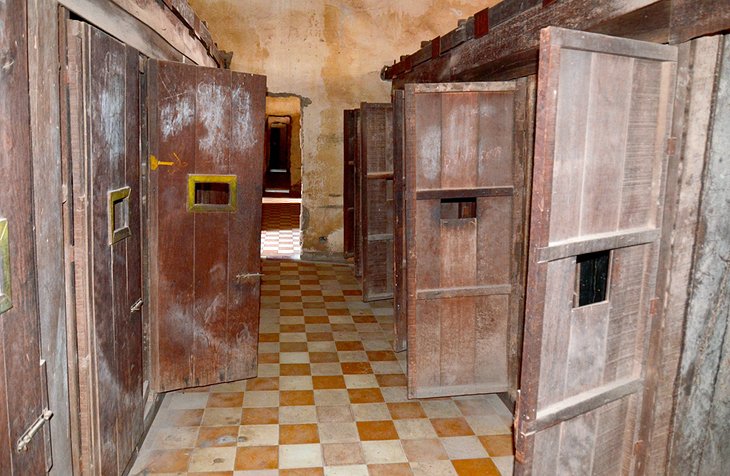
It was here, in the Khmer Rouge's Security Prison S-21 that some of the regime's worst torture atrocities were carried out. More than 17,000 people passed through these gates between 1975 and 1978, accused of betraying the revolution in some way.
Nearly all prisoners brought here were once themselves members of the Khmer Rouge who were turned on during one of the regime's many internal purges.
The visiting experience is made ever more visceral by the displayed photographic evidence hanging on the walls of the sparse cells next to empty beds. S-21 was exceedingly well-managed by Comrade Duch (the head of the prison) who made sure that extensive records were kept. As the prison was hastily abandoned when the Vietnamese took Phnom Penh in 1979, the detailed notes and photographs have survived.
Address: Street 113, Phnom Penh
5. Cruise on Phnom Penh's Rivers
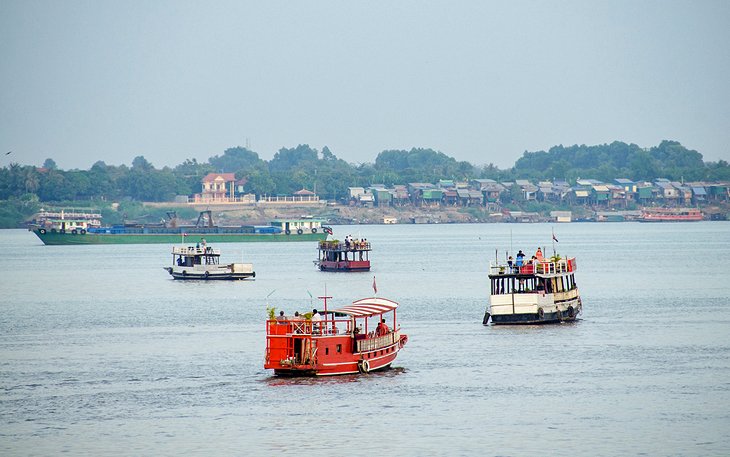
Phnom Penh is a riverine town, and one of the most relaxing ways to go sightseeing in the city is to take to the water. There are regular sunset cruise tourist boat departures from the riverfront between 5pm and 7.30pm, which head along the Tonlé Sap and Mekong Rivers.
Alternatively, you can also hire a private boat nearby to head out on the water at any time of the day (you'll want to put your bargaining hat on though, if you'd like to hire a private boat).
This is a great way to get away from the bustling motorbike-clogged streets for an hour and soak up the gentler pace of local river life.
Address: Tourist Boat Dock, Sisowath Quay, Phnom Penh
6. Wat Phnom
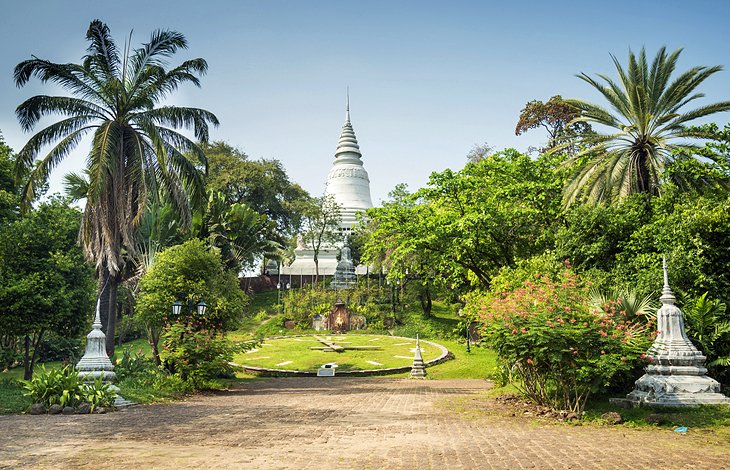
Phnom Penh is decidedly flat. The only rise in the landscape here is the 27-meter-high hillock that is home to the temple of Wat Phnom.
The first religious building on this spot is thought to have been constructed in the 14th century and has been rebuilt several times, with the current main temple sanctuary dating from 1926.
This is one of the city's most important Buddhist temples and is often bustling with locals leaving offerings here and praying at the various shrines that surround the main sanctuary.
Address: Norodom Boulevard, Phnom Penh
7. See the Stupas of Wat Ounalom
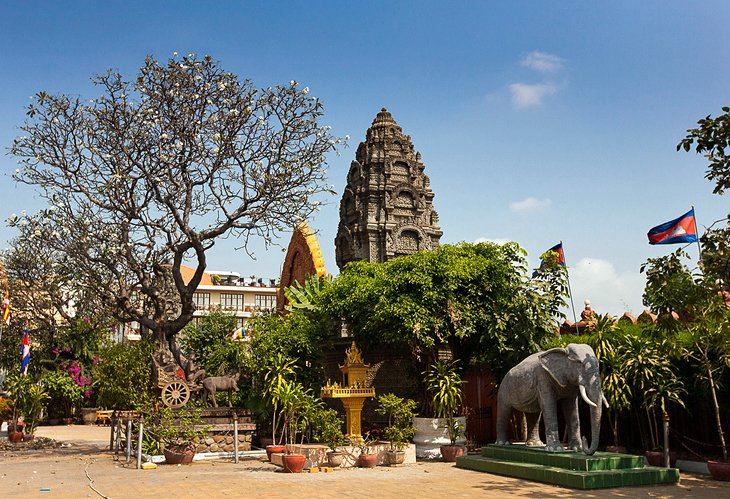
The most important temple complex in Cambodia, Wat Ounalom is the headquarters of Buddhism in the country. A stupa within the complex contains one of the Buddha's eyebrow hairs.
The wat was first situated here in 1443 and although it suffered considerable damage during the Khmer Rouge era, with many of its statues and religious iconography destroyed, it is thriving again today.
Of particular note for visitors is a beautiful Buddha statue in the main building's third floor that has been reassembled after being smashed to pieces by the Khmer Rouge and a statue commemorating Huot Tat, the fourth patriarch, who was murdered by Pol Pot, on the 2nd Floor.
Address: Sothearos Boulevard, Phnom Penh
8. Shop in the Russian Market
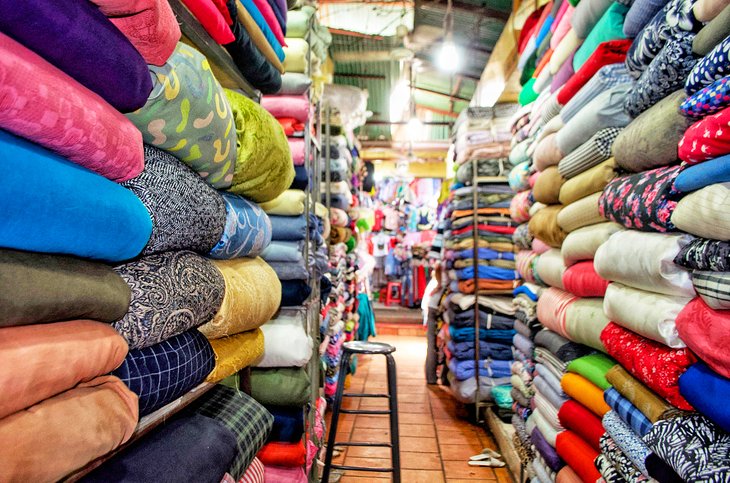
Phnom Penh's chaotic and lively Russian Market hums with local life, and produces some great shopping opportunities as well.
You'll find everything here from tacky souvenirs (much made in neighboring Thailand rather than locally produced) to beautifully-made local wooden handicrafts and Cambodian silks, along with bundles of stalls selling exceedingly cheap clothing.
This is not the place to come for some midday browsing, as temperatures skyrocket within the market, so aim for an early morning visit. The market opens for business at 6am.
This is also just the place to put your haggling hat on and try out your bargaining skills.
The market's real name is Psar Tuol Tom Pong, but earned its moniker due to the number of Russian foreign residents of Phnom Penh who used to shop here.
Address: Street 155, Phnom Penh
9. Experience the Psar Thmei Shopping Scene
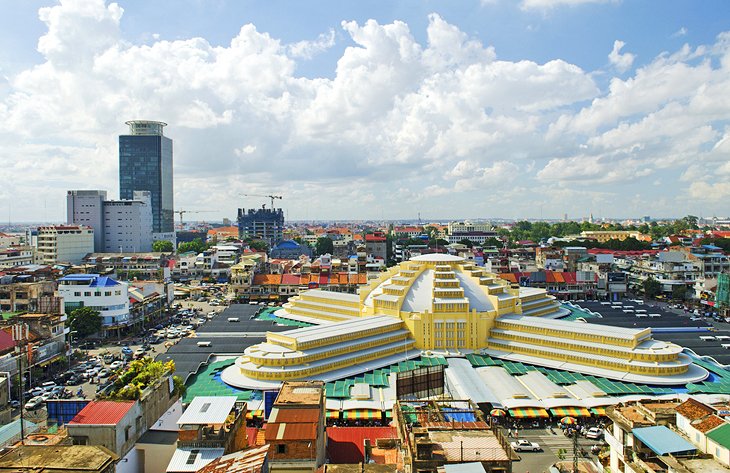
The distinctive domed building that holds the central Psar Thmei market was built in 1937 in Art Deco style and dominates Phnom Penh's central city. There are excellent opportunities for soaking up a slice of local life here with the market's huge array of local produce on display and plenty of hustle and bustle.
Everything is sold here, from fresh fruit and vegetables to jewelry and clothing, and the market is abuzz with energy from early in the morning to early evening.
It's a great place for an aimless wander, and keen photographers will find plenty of colorful scenes to capture.
Address: Street 126, Phnom Penh
10. See Phnom Penh's Independence Monument
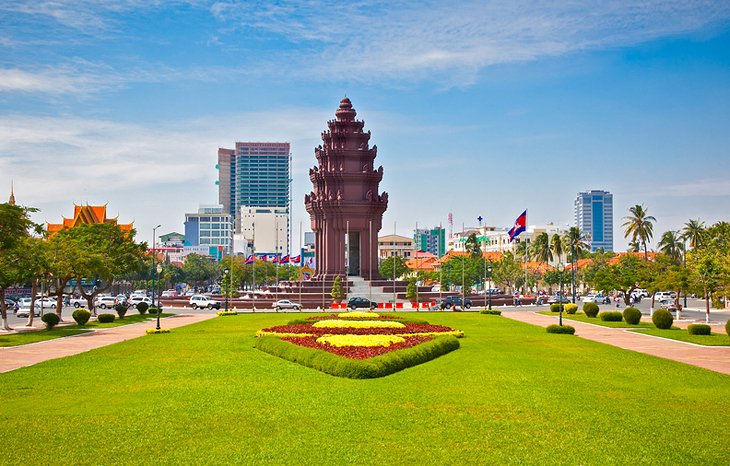
The patch of grass that intersects Sihanouk and Norodom Boulevards is home to Phnom Penh's Independence Monument, built to celebrate Cambodia's independence from French colonial rule in 1953. The sandstone structure represents an Angkorian temple, intricately decorated with nagas (multi-headed snakes).
As well as commemorating the nation's independence, the monument is now also a memorial to Cambodia's war-dead.
Just a short stroll from the monument is the green stretch of Wat Botum Park where you'll find the Cambodia-Vietnam Friendship Monument, built in 1979 after Vietnamese forces had defeated the Khmer Rouge.
Address: Sihanouk Boulevard, Phnom Penh
11. Watch the Cambodian Living Arts Performance
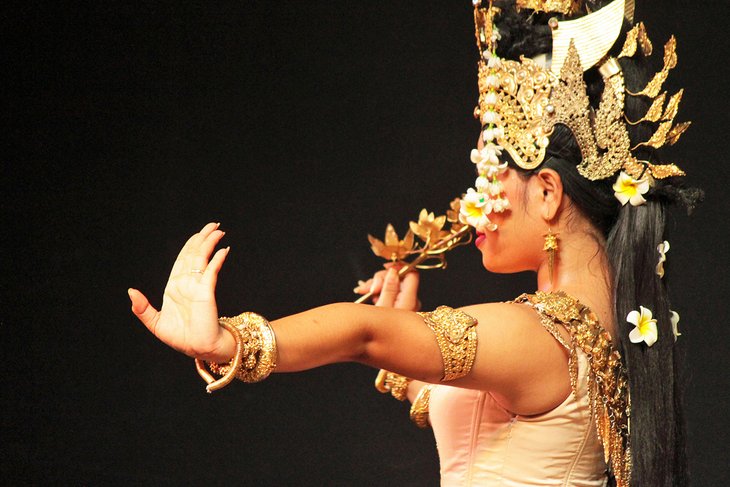
Traditional Khmer classical dance originated in the royal courts and wasn't introduced to the general public until the mid-1900s.
Today, a number of theatrical performances can be seen in Broadway-like shows around Cambodia, where costumed dancers recreate epic poems and legends through elaborate moves.
If you're in Phnom Phen, a great way to see this first hand is to join the Experience Cambodian Living Arts, Dance Show tour.
The tour starts at the National Museum of Phnom Penh, where you'll be able to discover the gardens and see stunning examples of Khmer art and architecture. The tour then continues on to a dinner theater, where you'll experience dining while enjoying a Cambodian traditional dance and music performance on stage.
12. Stroll Sisowath Quay
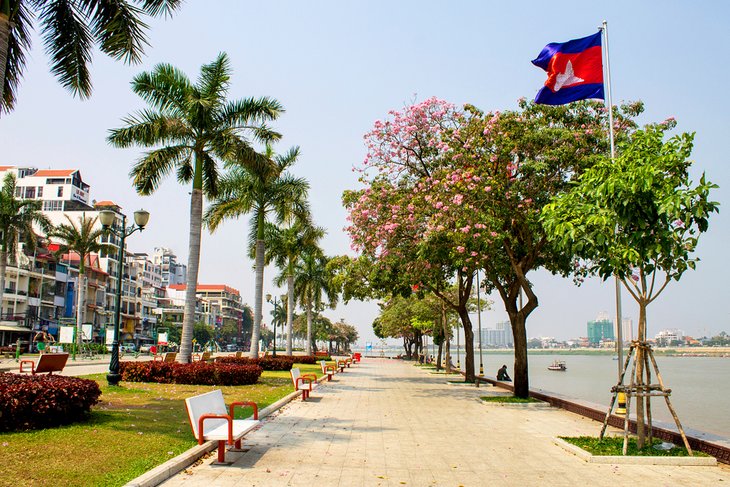
Sisowath Quay is Phnom Penh's most popular promenading spot and is always busy at sunset with walkers and joggers.
This riverside strip, rimmed with palm trees, stretches north for three kilometers from the Royal Palace. It's a great spot for watching and taking photographs of boats on the Tonle Sap River.
There are cafés, as well as street stalls selling food dotted along the route as well, so it's a popular spot for simply hanging out, particularly in the early evening.
A stroll here is easy to combine in a sightseeing itinerary between visits to the Royal Palace and Wat Phnom, just west of the quay's northern end.
13. Cycle around Koh Dach & Koh Okhna Tei Islands
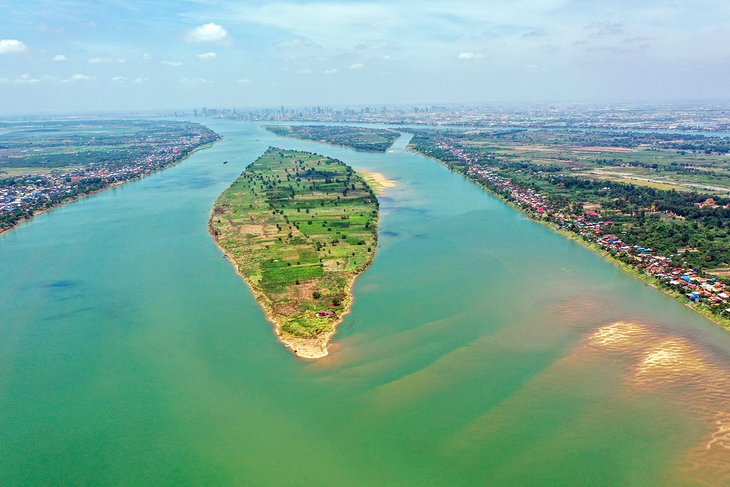
Koh Dach and Koh Oknha Tei (both more commonly referred to as Silk Island by foreign visitors) are two Mekong River islands linked together by a bridge, sitting about 10 kilometers north of the central city.
The islands are known by their "Silk Island" moniker due to the large community of silk weavers who live on Koh Dach and Koh Oknha Tei. It's normal for visitors here to be invited into local workshops to watch weavers at work and look at the silk products they're selling.
Both islands make a good option for a day trip. There's not a huge amount to do here, but it's a tranquil rural break within easy reach of the big city. The easiest way to get around on the island if you want to explore them fully is to rent a cycle.
Ferries leave regularly to both Koh Dach and Koh Oknha Tei from three separate ferry stops on the river banks opposite the islands. Some tour boat operators in Phnom Penh also offer tours here.
14. Take in the Views from the Temples of Oudong
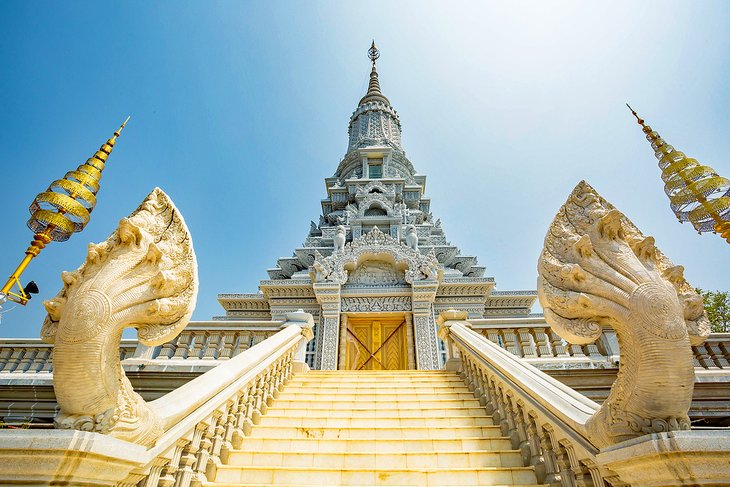
In Oudong, 43 kilometers north from central Phnom Penh, the stupas and temples atop the hill of Phnom Preah Reach Throap are well worth a trip from town, particularly if you want to enjoy some excellent vistas from the hill top, across the surrounding countryside.
The large temple of Vihear Preah Ath Roes with its 20-meter-high Buddha is the hill top's main attraction.
Other temples and stupas here range in age from the 17th century to the modern era. Some of the buildings with the most interesting intricate facade decorations include the Ang Doung stupa built by King Norodom and the Mak Proum stupa built by King Monivong.
15. Take a Day Trip to Phnom Chisor
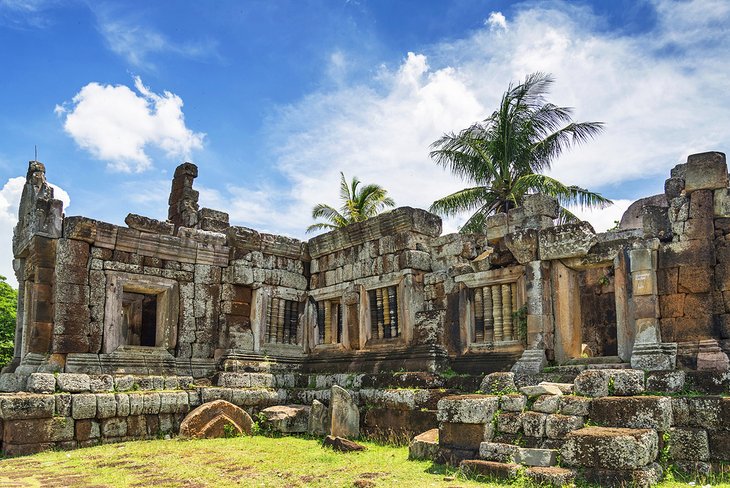
About 70 kilometers south of central Phnom Penh, the temple of Phnom Chisor sits on the 133-meter-high hilltop of Chisor mountain. The brick temple was built by the Angkorian Empire KIng Suryavarman I and is dedicated to the Hindu gods Vishnu and Shiva. It dates from the 11th century.
The staircases to get up to the temple are quite an effort if it's hot, but the sprawling views of the surrounding landscape below with its patchwork of lush green farming plots and rice fields between trees, are well worth it.
Most people hire a private driver or take a tour to come here, as there's no direct transport. Try to get here early to beat the heat.
Map of Attractions & Things to Do in Phnom Penh
Where to Stay in Phnom Penh for Sightseeing
We recommend these great-value hotels and guesthouses in Phnom Penh, near the top attractions in town:
- La Rose Suites: This luxury boutique hotel has a fantastic location and offers four-poster beds, beautiful pools, and complimentary massage.
- iRoHa Garden Hotel & Resort: With mid-range pricing, welcoming staff, a peaceful setting in the embassy district, and lovely pool, it's hard to beat this hotel.
- G Mekong Hotel: Affordable rates, helpful staff, comfortable rooms and a rooftop pool are some of the main attractions of this property.
- Angkor International Hotel: This centrally located budget hotel features large air-conditioned rooms with comfortable beds.
Frequently Asked Questions
When is the best time to visit Phnom Penh?
| Average minimum and maximum temperatures for Phnom Penh, Cambodia in °C | |||||||||||
| J | F | M | A | M | J | J | A | S | O | N | D |
| 31 22 | 33 22 | 34 23 | 35 24 | 34 24 | 33 24 | 32 24 | 32 24 | 31 24 | 31 24 | 30 23 | 30 22 |
| PlanetWare.com | |||||||||||
| Average monthly precipitation totals for Phnom Penh, Cambodia in mm. | |||||||||||
| 8 | 10 | 36 | 79 | 145 | 147 | 152 | 155 | 226 | 252 | 140 | 43 |
| Average minimum and maximum temperatures for Phnom Penh, Cambodia in °F | |||||||||||
| J | F | M | A | M | J | J | A | S | O | N | D |
| 88 71 | 91 72 | 93 74 | 95 76 | 93 76 | 91 76 | 90 76 | 90 76 | 88 76 | 87 76 | 86 74 | 86 71 |
| PlanetWare.com | |||||||||||
| Average monthly precipitation totals for Phnom Penh, Cambodia in inches. | |||||||||||
| 0.3 | 0.4 | 1.4 | 3.1 | 5.7 | 5.8 | 6.0 | 6.1 | 8.9 | 9.9 | 5.5 | 1.7 |
While other Southeast Asian countries experience slightly cooler seasons at some point of the year, Cambodia is hot all year long.
Because of this, the best time to visit Phnom Penh and Cambodia in general is during the dry season, which runs from November to January. While temperatures won't actually be much lower during these months, humidity drops considerably, making the weather more bearable.
This also means lots of people choose these months to visit, so prices go up and you are unlikely to find any discounts on airfares, hotels, or package tours.
If costs are an issue, consider arriving during the hot season, which runs from February until mid-May.
With temperatures in the high 30s and very high humidity, these aren't great months to tour the temples of Angkor Wat and nearby Siem Reap, but things are not as bad in the capital city - just make sure your hotel has a pool and organize your outdoor excursions for the early morning or the evenings.
Heavy southwest monsoon rains hit Phnom Penh from May to October, with the strongest storms happening in August and September.
In the city, this can mean flooding and lots of mosquitoes but also lots of beautiful thick greenery, dramatic electric storms, and a concert of geckos singing well into the night. This is the cheapest time of the year to visit and a great time to see the real Phnom Penh without masses of tourists around.
How far is the airport from the city and what is the best way to get there?
The Phnom Penh Airport is just 10 kilometers from the city center - a distance that could take anywhere from 30 to 60 minutes to cover, depending on your choice of transportation and how bad the infamous Cambodian traffic jams are that day.
For time efficiency, the best choice is the shuttle run by the Royal Railway Cambodia, which runs straight from the airport to the Phnom Penh Railway Station, right in the city center; the trip takes half an hour with no stops.
You can also catch public bus number 3 at the airport, which runs every 15 minutes and takes you all the way to the Night Market in the center of the city. The ride takes about an hour, and the bus makes about 20 stops, so you could always get off at a different place if it's more convenient to get to your hotel.
If the weather cooperates (and you don't arrive during a heavy downpour in the rainy season), a tuk-tuk might be your best option, as it will drop you off right at your hotel's door. Tuk-tuks are open taxis that charge flat rates - how much you'll pay for the ride to the city center depends on your negotiation skills, so be ready to discuss prices. There are always tuk-tuks parked just outside the arrival area of the airport waiting for passengers.


